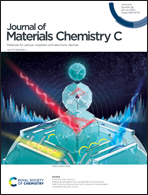Te3O3(PO4)2: a phosphate crystal with large birefringence activated by the highly distorted [TeO5] group and antiparallel [PO4] pseudo-layer†
Abstract
Phosphate crystals typically display small birefringence, due to the very small polarizability anisotropy of the highly symmetric [PO4] tetrahedral unit. Here, we discovered a novel phosphate crystal, Te3O3(PO4)2, which exhibits an unexpectedly enhanced birefringence of 0.148 at 1064 nm, which hits a new high in inorganic phosphate materials. Theoretical calculations and structural analysis reveal that the large birefringence can be attributed to the combined effects of the highly distorted [TeO5] group and antiparallel [PO4] pseudo-layer. Notably, bulk Te3O3(PO4)2 single crystals can be grown by the Czochralski method, and a centimeter-size crystal has been successfully obtained. Moreover, the Te3O3(PO4)2 crystal exhibits a wide transmission range (0.29–4.76 μm) and a high laser damage threshold (544 MW cm−2). These excellent properties suggest that Te3O3(PO4)2 is a potential phosphate birefringent material. More importantly, this work confirmed that the distorted [TeO5] group and antiparallel [PO4] pseudo-layer are two excellent functional units for increasing birefringence, which provides a novel strategy for the further design of new phosphate compounds with large birefringence.
![Graphical abstract: Te3O3(PO4)2: a phosphate crystal with large birefringence activated by the highly distorted [TeO5] group and antiparallel [PO4] pseudo-layer](/en/Image/Get?imageInfo.ImageType=GA&imageInfo.ImageIdentifier.ManuscriptID=D0TC02311F&imageInfo.ImageIdentifier.Year=2020)
- This article is part of the themed collection: Journal of Materials Chemistry C HOT Papers


 Please wait while we load your content...
Please wait while we load your content...